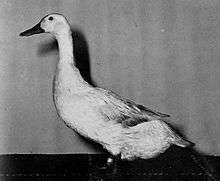Welsh Harlequin
The Welsh Harlequin is a breed of domestic duck originating in Wales. In 1949, in Criccieth, Group Captain Leslie Bonnet discovered a colour mutation among his flock of Khaki Campbells and began Breeding selectively for the trait. By 1968, hatching eggs were exported to the United States, followed by the importation of live birds in 1981.

Today, the Welsh Harlequin is a light-weight duck breed known for its vivid plumage and egg laying ability. Over the years the colour and conformation of the breed has changed, indicating that likely new blood of another breed has been introduced [1]. Welsh Harlequins weigh 4.5 to 5.5 pounds (2-2.5 kilos). Females have a black bill and brown legs and feet, and their plumage is similar to a mallard but heavily frosted with white. They also lack the eye stripes of mallard females. Drakes are also similar to a heavily frosted Mallard with a yellow/green bill and orange legs and feet. There is also a color variation known as "golden", popular in the UK, which replaces the black feather pigments with a light golden brown color.[2] Welsh Harlequins have a unique, natural sex-linked characteristic[1]. As day olds, sex can be determined based on bill colour with over 90% accuracy. Young drakes will have darker bills while female with have lighter with a dark spot at the tip of the bill [1].
The birds produce a lean carcass and are active foragers, though they are sometimes more vulnerable to predators such as birds of prey due to their light colouration. The egg laying ability is highly valued as the production exhibited by some hens rivals that of chickens. The breed is prone to broodiness and a pair can easily produce young without human interference. They have become a popular backyard pet in recent years due to the bird's calm demeanor and high egg production.
The Welsh Harlequin was admitted to the American Poultry Association's Standard of Perfection in 2001. The breed is considered to be critically endangered in North America by the American Livestock Breeds Conservancy, with only 188 breeding birds found in a 2000 census.
See also
References
- 1 2 3 Holderread, Dave (2001). Storey's Guide to Raising Ducks. North Adams, MA, USA: Storey Publishing. p. 42.
- ↑ American Poultry Association Standard of Perfection, 2010
- Ekarius, Carol (2007). Storey's Illustrated Guide to Poultry Breeds. Storey Publishing. ISBN 978-1-58017-667-5.
- "Welsh Harlequin Duck". Rare Breeds Watchlist. American Livestock Breeds Conservancy.
- "Welsh Harlequin Ducks". feathersite.com.